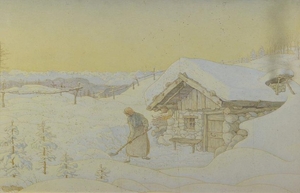BORIS GEORGIEV Happiness hut. .
Happiness hut. . Fresco on hardboard. Cm 83,50 x 52,00. Publication: Plamena Dimitrova Racheva, Boris Georgiev of Varna, Ed. Kibea, p. 29 e 112. Collection Virginia Giacometti, Italy. The landscape depicts the small hut in the Venetian Alps where the artist lived for several years with his younger sister Katya. In the introduction to his 1929 Berlin exhibition, Boris Georgiev told the following story: "Then I built myself a hut in the Venetian Alps so that I could stay forever with the shepherds, the peasants and the beasts, to make my living with my two hands, from the earth, through hard work. I was hoping that I would thus become free from the awful slavery to society, for society regards the artist as a beggar, so that when the beggar starves to death, the society may profit from the works of his suffering. It almost seemed that I had reached the peak of my happiness a mortal man could have in this world, I seemed to have attained, particularly when my sister, a creature of heavenly kindness and spirituality, joined me to share my new life. Although younger than me, it was she who showed me the possibility for a purer life, for spiritual and moral beauty, and the way that led to them". Information about the Happiness hut is found in a 1962 letter from Nikola Soychev of Pazardjik to writer Mihail Kremen. The letter reads: "In one of his drawings Boris Georgiev depicted his sister Katya shoveling snow in the yard of their snow-covered hut. The hut in question was built by Georgiev himself in Monte Lefre, near Trentino in the Alps, where he has been living with the shepherd for about two years. Looking at the drawing, one would say that Georgiev is a sympathetic recorder of his contemporary life. He documents each day with a perfect picture. Katya takes a keen interest in poetry and music. Boris Georgiev himself occasionally plays the mouthorgan and the piano. He is impressed by the music of Chopin, Beethoven, Mozart and Tchaikovscky. He also loves flowers". The reviews of the artist's exhibition in Brazil mention that it was in mountain home that the artist adopted "the secret teaching of spiritual seclusion amidst the mysteries of nature". It was here that Georgiev created such insightful paintings as "The Eternal Road", "Ave Natura", "Winter", "Contemplation", "Ecce home", and the "Weltschmerz" triptych that he described as his autobiography, as the diary of his soul. . Frame present
[ translate ]View it on
Sale price
Estimate
Time, Location
Auction House
Happiness hut. . Fresco on hardboard. Cm 83,50 x 52,00. Publication: Plamena Dimitrova Racheva, Boris Georgiev of Varna, Ed. Kibea, p. 29 e 112. Collection Virginia Giacometti, Italy. The landscape depicts the small hut in the Venetian Alps where the artist lived for several years with his younger sister Katya. In the introduction to his 1929 Berlin exhibition, Boris Georgiev told the following story: "Then I built myself a hut in the Venetian Alps so that I could stay forever with the shepherds, the peasants and the beasts, to make my living with my two hands, from the earth, through hard work. I was hoping that I would thus become free from the awful slavery to society, for society regards the artist as a beggar, so that when the beggar starves to death, the society may profit from the works of his suffering. It almost seemed that I had reached the peak of my happiness a mortal man could have in this world, I seemed to have attained, particularly when my sister, a creature of heavenly kindness and spirituality, joined me to share my new life. Although younger than me, it was she who showed me the possibility for a purer life, for spiritual and moral beauty, and the way that led to them". Information about the Happiness hut is found in a 1962 letter from Nikola Soychev of Pazardjik to writer Mihail Kremen. The letter reads: "In one of his drawings Boris Georgiev depicted his sister Katya shoveling snow in the yard of their snow-covered hut. The hut in question was built by Georgiev himself in Monte Lefre, near Trentino in the Alps, where he has been living with the shepherd for about two years. Looking at the drawing, one would say that Georgiev is a sympathetic recorder of his contemporary life. He documents each day with a perfect picture. Katya takes a keen interest in poetry and music. Boris Georgiev himself occasionally plays the mouthorgan and the piano. He is impressed by the music of Chopin, Beethoven, Mozart and Tchaikovscky. He also loves flowers". The reviews of the artist's exhibition in Brazil mention that it was in mountain home that the artist adopted "the secret teaching of spiritual seclusion amidst the mysteries of nature". It was here that Georgiev created such insightful paintings as "The Eternal Road", "Ave Natura", "Winter", "Contemplation", "Ecce home", and the "Weltschmerz" triptych that he described as his autobiography, as the diary of his soul. . Frame present
[ translate ]


